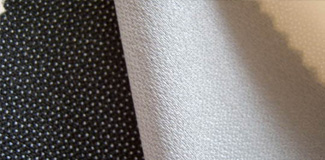Clothing lining is a big kind of clothing materials, which play a role in skeleton on clothing. By lining modeling, reinforcement, conformal action, in order to form all sorts of beautiful clothing styles.
It is actually a simple fabric clothing outside, the inside of the lining, the middle is the lining, interlining under normal circumstances can not be seen directly, but those who need to develop stiffness, full handle, smooth transition, reinforced position, are covered interlining.
(1) clothing lining: that garment processing, in order to display the garment design features, apply to all parts of the inner garment of a textile material.
(2) fabric: commonly known as the base fabric, woven fabric lining used.
(3) cotton lining: that without finishing or sizing only stiffened cotton or linen, is more primitive lining.
(4) Woven resin black carbon lining: wool lining, also known, it is made of cotton, chemical fiber, wool spinning pure or blended as a veil, chemical fiber and yak wool or other animal wool as weft, the woven fabric, and by lining made of resin finish.
(5) Woven resin lining: cotton and chemical fiber pure spinning, blended woven or knitted fabrics, the bleaching or dyeing and other finishing, and finishing is made by resin lining. Acronym resin lining.
(6) woven (or knitted) hot melt interlining fabric: cotton and chemical fiber pure spinning or blended woven or knitted fabrics, the bleaching or dyeing and other finishing, and made after the thermoplastic hot melt adhesive applied uniformly interlining. Acronym woven interlining.
(7) Non-woven hot melt adhesive interlining cloth: also known as non-woven interlining. It refers to a non-woven fabric lining after processed into a thermoplastic hot melt adhesive coating. Stitching is also owned by the non-woven interlining in this category.
Woven resin black carbon lining, woven resin lining, woven (including knitting) hot melt adhesive interlining cloth and non-woven fabric is heat-fusible interlining four series of modern interlining. In addition, there are a variety of other lining and related products, such as neckties lining, hemp lining, waist lining and waist moldings and picture with lining, pockets, shoes lining
Garment interlining of the skeleton, good lining is the essence of clothing, in particular the application of modern lining, making costumes and sewing process to get unexpected results, the role of the lining can be broadly summarized as follows:
1, giving the garment a good curve and shape;
2, enhanced clothing crisp and flexibility, enhanced three-dimensional;
3, to improve the drape of clothing and fabrics feel, enhanced comfort clothing;
4, increase the thick of clothing, a sense of fullness and insulation;
5, to prevent garment deformation, so wear clothing after washing to maintain the original shape;
6, there are some local clothing reinforcement and reinforcement.
Garment interlining industry, said "skeleton" and "essence", especially in the modern new interlining applications, but the shape and sew clothing get unexpected results
Classification
Lining parts used are: the front panel of clothing, inner welt collar, lapels, after the film, pocket, flap, belt, lead, placket, cuffs, welt, long sleeve, spigot, Hem fork mouth, sleeve fork
Interlining, woven interlining, non-woven lining, moldings lining, double lining, waistband lining, shirts lining, jacket lining, fur lining, composite lining (depending on the situation points)
Interlining and fabric adhesive
1, can be firmly bonded with the fabric, after bonding soft and full of crisp, resilience, after bonding the fabric surface wrinkles reply quickly.
2, a lower bonding temperature, shrinkage of the fabric coordination.
3, the amount of adhesive is applied uniformly, fixing a uniform amount, adhesives no leakage, corrosion die of, and long-term storage of the same adhesive performance.
4, cutting between the lining does not stick to one another, stick cutting knife, stick a sewing needle, sewing machine, when feed slip.
5, without prejudice to the physiological clothing, such as permeability.
Prerequisites interlining and fabric adhesive
1 ,. bonders: bonders general there are two kinds of peace drum plate.
2. Conditions bonding: The adhesive bonding conditions include temperature, time and pressure Pressing three areas. When the three elements interact within a certain range of a definite link. Raising the temperature, pressures, then Pressing time can be relatively short, and vice versa. Temperature, pressure hot time, it is easy to destroy the fabric of performance and color, but also easy to produce transparent plastic, the pressure is too large, easy to damage the fabric (especially light fabrics) appearance.
3, the choice of bonding conditions: Before mass production, the conditions must be adhered trial to determine the optimum process conditions (when the test sample, interlining supplier shall provide bonding conditions for reference).
Interlining and fabric bonded. The peel, if hot melt adhesive on the lining and the fabric equally distributed, then the appropriate bonding conditions, or should be retested. After bonding cloth for a smooth, wrinkle-free, no foam, no transparent plastic. After bonding, to peel strength, dry cleaning, washing performance test results must meet the requirements of production. Bonding effect to be achieved clothing style, features requirements.














